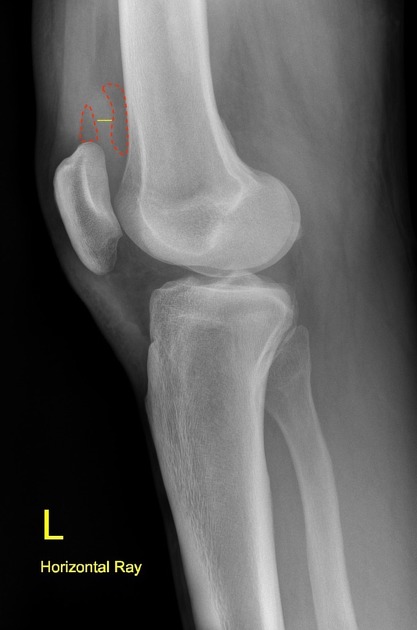A joint effusion is defined as an increased amount of fluid within the synovial compartment of a joint.
There is normally only a small amount of physiological intra-articular fluid. Abnormal fluid accumulation can result from inflammation, infection (i.e. pus) or trauma and might be exudate, transudate, blood and/or fat. As part of an arthrogram, deliberate injection into the joint space of a contrast medium results in an iatrogenic effusion.
Lipohemarthrosis is a particular type of effusion that occurs in the setting of intra-articular fracture where a fat-fluid level is seen due to marrow fat leaking into the joint via the fracture. Fat, being less dense than blood, will float to the surface and present as a 'fat-fluid' level on top of the blood on any radiographs with the horizontal beam parallel to the level. Lipohemarthroses can occur in other joints (e.g. shoulder) but are most readily identified in the knee.
Recognition of joint effusion on plain radiographs can be difficult, particularly for non-radiologist. Appreciation of the typical appearances and signs of joint effusions can assist diagnosis.
Radiographic features
Plain radiograph
Knee joint effusion
A knee joint effusion appears as well-defined rounded homogeneous soft tissue density within the suprapatellar recess on a lateral radiograph. The effusion will 2:
separate periarticular fat pads >10 mm
obliterate the normally crisp posterior border of the quadriceps tendon
displace the quadriceps tendon and patella anteriorly
Elbow joint effusion
The sail sign is the key to recognizing an elbow joint effusion. On a lateral radiograph, effusion causes displacement of the anterior and posterior fat pads surrounding the distal humerus. The triangular appearance of the displaced low-density fat pad simulates the appearance of a sail.
An elbow joint effusion in the setting of trauma is very often a sign of an occult fracture. In adults, the occult fracture is most commonly of the radial head, whilst in children, a non-displaced supracondylar fracture should be suspected.
Ankle joint effusion
An ankle joint effusion is best seen as a teardrop-shaped soft tissue density displacing the anterior fat pad on a lateral film and lying superior to the talar neck. Effusion within the posterior recess is usually less well-defined. Plain films are sensitive for effusions >5 mL, with US and MRI being more sensitive for smaller effusions 3.
Hip joint effusion
Hip joint effusions are easiest identified on US, CT and MRI. They are difficult to identify on plain radiographs with only one reliable sign described 5:
asymmetrical widening >1 mm in teardrop distance (between the lateral aspect of the pelvic teardrop and most medial aspect of the femoral head)
Ultrasound
Knee joint effusion
Evaluation begins with probe placement just cephalad to the patella, allowing identification of the quadriceps tendon in the near field and cortex of the femur in the far-field; between these two structures lies the suprapatellar recess of the knee joint, intercalating between the suprapatellar and prefemoral fat pads. Caudad angulation allows visualization of the lateral and medial joint recesses. An effusion will cause distension of the visualized recesses with fluid, which may be anechoic or of mixed echogenicity. No internal color flow Doppler signals should be detected, and probe compression should result in a change in shape or internal movement within the collection 7.
Elbow joint effusion
Probe placement over the coronoid fossa anteriorly and olecranon fossa posteriorly allow evaluation of the anterior and posterior joint recesses, respectively. An effusion will manifest as distension of the joint recess appearing to fill the visualized fossa with fluid as well as elevation of the overlying joint capsule and fat pad 6. The posterior recess with the joint in flexion may afford the optimal view.















 Unable to process the form. Check for errors and try again.
Unable to process the form. Check for errors and try again.